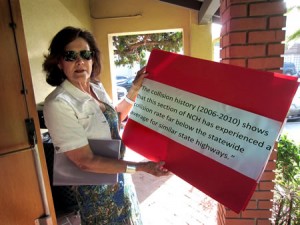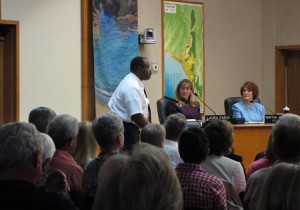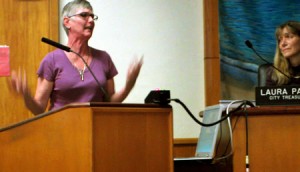
Even after a heart-rending plea from a mother whose son was killed when his motorcycle was hit by an exiting Emerald Bay resident, the City Council on Tuesday unanimously rejected a proposed traffic signal at the gated community’s main entry.
Against a backdrop of emotional pleas, venomous emails and threats of a political backlash, the Emerald Bay traffic signal proved the most divisive issue council members said they have ever faced. It also revealed lingering resentment over Emerald Bay’s elite legacy as an unincorporated, gated community now within city borders that bars public beach access but is exempt from complying with the city’s ordinances and development rules.
After hearing nearly two hours of testimony, the council leaned toward signal opponents, who had deluged them with more than 300 emails and phone calls. The council voted 5-0 to allow street improvements outside Emerald Bay to relieve traffic backing up for entry at the guarded gatehouse at Shamrock Road and North Coast Highway, but refused to green-light installation of a left-turn signal.
“I’m willing to offer kind of an olive branch,” said council member Kelly Boyd. “I’m not sure that I can go all the way with the signal at this time.” Boyd made the motion to have traffic conditions monitored there while requiring Emerald Bay to apply for a city coastal development permit to begin traffic-alleviating improvements at the main entrance. The council concurred.
But Susan Thomas, past president of the Emerald Bay Community Association board, said Wednesday

that the council’s decision cancels all plans for the intersection. “None of this will be done,” said Thomas, “especially since all the experts agreed that the intersection is dangerous. No viable solution was presented.” Thomas said installing a signal would be a “minor expense” of $300,000 to $400,000 of the overall $3 million to improve the intersection.
Proposed improvements without the signal would push the main gate farther back from Coast Highway, increase the length of turning lanes and add additional entry and exit lanes. Total costs with the signal, were estimated at more than $3 million with the Emerald Bay Homeowners’ Assn. and Service District footing the bill.
Council member Elizabeth Pearson called the unprecedented number of emails she received “the most vitriolic” she has seen in her 16 years in city government here.
“This is the one that really got to me,” she said. “ ‘Social fascism: when a wealthy and powerful few control, influence and crush the rights and safety of others. Please do not approve this light.’” Pearson, who described some of the emails as disgusting, views the controversy as an opportunity. “Come on, let’s start working with Emerald Bay, folks, and let’s try and bring them more into the community and welcome them more into it.”
Council member Toni Iseman pointed out that the issue revealed a festering resentment between city residents and the gated beach community. “The one email I printed out came in about five days ago,” said Iseman, “and ended with ‘This is a division in the community that we don’t know will ever heal and please help us make it go away.’ I think that’s the real tragedy of what’s gone on here.”
Supporters of the Emerald Bay left-turn half-signal called it a life-and-death safety issue.
“We don’t want anybody else to die there,” said Paula Negron, whose 19-year-old son, Aron, died eight

years ago after an Emerald Bay resident pulled out in front of him. A photo of her son was projected on a screen behind the council’s dais with the message “A Signal for Aron Negron.”
After an earlier hearing, city officials hired Fehr and Peers for $15,000 to independently review conditions at the intersection. On Tuesday, consultant Steve Brown outlined mixed findings, which showed a signal could have prevented two accidents that occurred between 2006 to 2010, but a four-year collision history “far below the statewide average for similar highways.” Brown said a signal typically reduces overall accidents, including the most dangerous side-swipe collisions, but increases rear-end smash-ups.
Despite the emotionally charged plea for a signal, opponents flagged the safety issue as a smokescreen for the convenience by Emerald Bay residents and claimed that a signal would cause more traffic accidents, specifically rear-end collisions.
George Patterson, a local resident and retired deputy sheriff, said he’s never seen a report listing a traffic signal as the cause of an accident. “The great majority of them are caused by human error, judgment on the driver’s part,” he said. “It wasn’t some mechanical device on the street. Putting a traffic light in isn’t going to change that any.”
But even within Emerald Bay, a vocal faction over the past two years has doggedly opposed the project, filing appeals with county planners and the Superior Court. Pete Collisson, former president of the Emerald Bay homeowners’ group, claimed that the safety issue is a subterfuge to keep the beach at Emerald Bay closed to public access.
“The service district was sitting on this pot of money, several million dollars in reserves,” said Collisson, “and didn’t know what to spend it on.” He said that if a beautification project was characterized as a safety issue, the service district could spend money without opening the gates of the bayside community to the public. “While the argument is being made that you’ll somehow be responsible for deaths and accidents and all these horrible things,” he attested, “in fact, the safety issue was an expedient that was adopted by the political powers that be in Emerald Bay.”
Others argued for a simpler solution to slow traffic along North Coast Highway. “Why hasn’t a flashing light been installed there 10 years ago?” asked Nuby Sears, an Emerald Bay resident who called the tragedies outside the gate heart-wrenching. “The main problem is people are going 60 miles an hour, maybe 70, entering into Laguna Beach. If people slow down, that’s what’s going to save lives.” Other suggestions to alleviate hazardous driving were to write more speeding tickets, lower the speed limit and test for sobriety.
Emerald Bay resident Steve Rabago started a petition opposing the signal on Change.org, which garnered 192 signatures. “That’s probably why you got all those emails. Sorry,” he said, addressing the council. The reasons given for opposing the signal, he summarized, were two blind corners and high downhill speeds, “accidents waiting to happen.”





Laguna Beach is roughly linear miles of pristine coastline cut in half by a high-speed freeway and operated as such by the California Department of Transportation (CALTRANS). The problem Emerald Bay experiences is high-speed motorized traffic encountering slower speed residential traffic and non-motorized traffic on the same roadway. This dangerous condition prevails the entire length of Laguna’s Coastline, not just in Emerald Bay. This condition can change simply by changing policy thereby changing the way the streets are operated. Both CALTRANS and cities are now mandated by Complete Streets Policy to balance four modes of transportation and do so safely. The sooner Laguna city government recognizes these mandates and adopts the new policy, the sooner we will drive safer Complete Streets. Read more about Complete Streets Policy at LagunaStreets.
Laguna Beach is roughly 5 linear miles of pristine residential coastline cut in half by a high-speed freeway and operated as such by the California Department of Transportation (CALTRANS). The problem Emerald Bay experiences is high-speed motorized traffic encountering slower speed residential traffic and non-motorized traffic on the same roadway. This dangerous condition prevails the entire length of Laguna’s Coastline, not just in Emerald Bay. This condition can improve simply by changing policy thereby changing the way the streets are operated. Both CALTRANS and cities are now mandated by Complete Streets Policy to balance four modes of transportation and do so safely. The sooner Laguna city government recognizes these mandates and adopts the new policy, the sooner we will drive safer Complete Streets. Read more about Complete Streets Policy at LagunaStreets.
My condolences to the family of the young man that was killed by a Emerald Bay resident. However, this is a glaring example of the “priveledged” residents disregard for the “untouchables of the world. The person who KILLED this young man obviously was not paying attention to passing traffic. My guess is that he/she was in a hurry and had no regard for others when exiting. Instead of installing a traffic signal that will further endanger ALL drivers, why not have the wonderful residents of Emerald Bay learn that they are a part of the community and must drive with the same vigilance as the rest of us.
[…] No-Go for Emerald Bay Traffic Signal […]